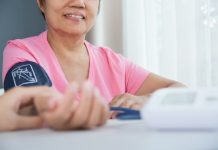
Researchers at Binghamton University have made significant strides in the field of fall prevention for older adults.
Their latest study, published in the journal Sensors, introduces a smartphone app designed to reduce the risk of falls in the elderly, a pressing concern given the high rate of fall-related injuries in this age group.
As people age, they often notice a decline in their balance. In the United States, one in four people over the age of 65 experiences a fall each year, leading to severe injuries or even fatalities.
Recognizing this issue, the team at Binghamton University’s Motion Analysis Research Laboratory, led by Vipul Lugade, associate professor of physical therapy, embarked on a mission to develop a solution.
Lugade explains that smartphones, a common item in many people’s pockets, can play a crucial role in evaluating and improving balance.
By utilizing the phone’s accelerometers, the app can measure the amount of body sway while a person stands still with the phone in their pocket. This measurement helps determine how stable a person is while standing.
The Motion Analysis Research Laboratory (MARL) at Binghamton University is equipped with advanced tools like a 12-camera motion analysis system, a system for muscle rehabilitation, an electronic walkway for measuring gait, and eye-tracking glasses.
One key piece of equipment in this study is the Computerized Dynamic Posturography (CDP) system. This system measures ‘postural sway’ by analyzing foot pressure and motor reactions, offering insights into an individual’s balance.
The study, which began in June 2022, aimed to explore how older adults’ ability to balance and multitask deteriorates with age.
By examining gait speed and balance, the researchers sought to demonstrate that improvements in these areas could lower the risk of falls. The ultimate goal was to test the effectiveness of their smartphone-based program in enhancing balance.
Of the 31 participants in the study, 29 completed all exercises and tests. The results showed no significant difference between the electronic and paper versions of the balance intervention.
Suzanne O’Brien, another lead researcher, emphasized the app’s potential as a safe tool for delivering balance exercises directly to users’ phones.
The team is optimistic about extending this technology to help patients with conditions like Parkinson’s disease and stroke.
The study also focused on engaging with participants, with weekly phone check-ins and in-person visits to ensure safety and monitor their well-being.
Despite some reporting fatigue and muscle soreness, the overall feedback was positive, indicating that seniors are capable of using the app effectively.
Beyond just collecting data, the researchers aim to make their findings beneficial to the community. In collaboration with Lijun Yin, a professor of computer science, they are developing a computer dashboard to analyze performance metrics and compare them with normal ranges.
The goal is to create a nationwide database that can aid clinicians in providing tailored care to their patients.
The team acknowledges the need for further improvements, such as increasing the sample size and reaching out to underrepresented communities.
They hope to make the technology more accessible and accurate, ultimately enhancing the well-being and safety of older adults.
If you care about health, please read studies that plant-based diets can harm your bone health without these nutrients, and this bone problem may strongly increase COVID-19 death risk.
For more information about wellness, please see recent studies that too much of this vitamin may increase your risk of bone fractures, and results showing this type of exercise may protect your bone health, slow down bone aging.
The research findings can be found in Sensors.
Copyright © 2024 Knowridge Science Report. All rights reserved.



